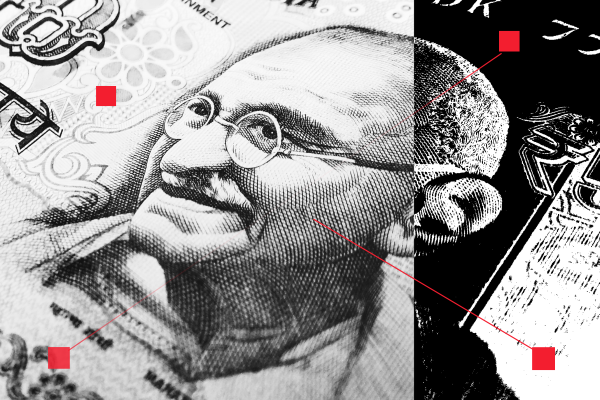Trading Signals 05/02 – 09/02
The Indian Rupee: Overview and Outlook

The Indian rupee (INR), denoted by the symbol ₹, serves as the national currency of the Republic of India. It is divided into 100 paise.
Translated from Sanskrit, “rupee” signifies a “silver coin.” The introduction of the rupee in India dates back to the 16th century. Throughout the 16th to 19th centuries, different regions within India circulated their own variations of the rupee. However, in 1835, a standardized silver rupee was established across British India, remaining in use until 1893. The issuance of paper banknotes commenced in the 18th century.
Presently, Indian banknotes are available in denominations of 5, 10, 20, 50, 100, 500, and 2000 rupees, while coins exist in values of 1, 2, 5, and 10 rupees, along with 50 paise. Banknotes with a denomination of 1000 rupees, as well as coins worth 10 and 20 paise, are no longer in active circulation.
The Indian Rupee holds a prominent position among currencies in emerging economies, buoyed by strong economic growth and support from the Reserve Bank of India (RBI). In comparison to other BRICS currencies, the rupee exhibits relatively lower volatility. This stability is noteworthy when contrasted with the higher volatility observed in the DXY index (dollar to 6 main currencies).
The Economy of India. Current Situation and Prospects
India boasts one of the world’s largest economies, experiencing steady growth since the 1990s when the country witnessed a peak in foreign investments in 1994. Categorized as an agrarian-industrial nation, India’s services sector, primarily driven by IT services, constitutes half of its GDP, while the government actively works towards market liberalization.
The agricultural sector contributes approximately 18% to the gross domestic product (GDP) and employs 60% of the population. The industrial sector accounts for around 28% of the GDP, with India’s energy consumption remaining among the highest globally. Coal and oil together make up 85% of India’s energy consumption. Although India possesses oil reserves covering 25% of its domestic demand, the country continues to maintain elevated levels of oil imports.
Emerging Risks for India
In recent years, India has faced constraining factors in its economic development, including a slowdown in external demand for Indian assets and the impact of COVID-19 outbreaks. The current situation, compounded by the consequences of the conflict in Ukraine and frequent and widespread lockdowns in China, particularly in key manufacturing centers, has slowed business activity between China and India, resulting in new disruptions in global supply chains.
Additionally, stronger, broader, and more sustained price pressures have prompted tighter monetary policies in many countries, thereby significantly increasing overall risks for economic prospects.
India has been predominantly an importing country, resulting in a negative trade balance over the past decade. However, it is worth noting that in cases where parity is disrupted, such as in 2020 when exports exceed imports, the Indian rupee remained relatively stable against the US dollar, primarily due to active interventions by the Reserve Bank of India in the foreign exchange market. Despite trade imbalances, the rupee has maintained its value against the US dollar, indicating the central bank’s efforts to stabilize the currency.
India’s GDP Growth
India exhibits some of the highest GDP growth rates globally, driven by a thriving business environment. However, due to its significant imports, the country is vulnerable to external shocks. For instance, during the peak of the pandemic in June 2020, the quarterly GDP growth rate plummeted by 24.4% year-on-year.
Nonetheless, the recovery has also been robust, with June 2021 witnessing a growth rate of 20.3% year-on-year. According to the government’s plan, India aims to become a five-trillion-dollar economy by 2025. The Reserve Bank of India forecasts a growth rate of 6.4% for the economy in 2023.
Meanwhile the IMF forecasts, the country is expected to achieve its set goals, albeit with a delay of two years, by 2027. In 2023, the IMF predicts a growth rate of 6.1% for India’s economy, followed by a projected growth rate of 6.8% in 2024. These projections indicate the confidence of analysts in India’s economic trajectory and the potential for substantial growth in the coming years.
Currency pair USD/INR. August 2023 Forecast
The depreciation of the Indian rupee against the US dollar is expected to persist. Analysts anticipate that the USD/INR pair can rise to 83 – 84 in August and undergo a slight correction in the last quarter of 2023 following a slowdown in inflationary pressures. The scenario of the pair moving beyond the mentioned range is unlikely, except in the case of a global recession.
The trend towards dollarization of the Indian economy poses a significant risk factor for the rupee, and the reversal of rupee’s decrease since 2018 appears unlikely at present.
Oil: A Review of Early 2024
China’s Economy: Early 2024
Simple Strategy for Beginner Traders

